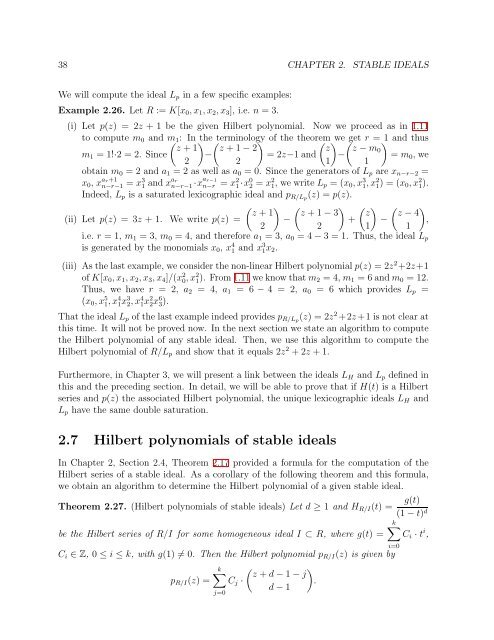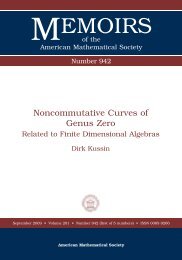University of Paderborn Department of Mathematics Diploma Thesis ...
University of Paderborn Department of Mathematics Diploma Thesis ...
University of Paderborn Department of Mathematics Diploma Thesis ...
Create successful ePaper yourself
Turn your PDF publications into a flip-book with our unique Google optimized e-Paper software.
38 CHAPTER 2. STABLE IDEALSWe will compute the ideal L p in a few specific examples:Example 2.26. Let R := K[x 0 , x 1 , x 2 , x 3 ], i.e. n = 3.(i) Let p(z) = 2z + 1 be the given Hilbert polynomial. Now we proceed as in 1.11to compute m 0 and m( 1 : In ) the( terminology ) <strong>of</strong> the theorem ( we( get r = ) 1 and thusz + 1 z + 1 − 2z z − m0m 1 = 1!·2 = 2. Since −= 2z−1 and − = m 0 , we2 21)1obtain m 0 = 2 and a 1 = 2 as well as a 0 = 0. Since the generators <strong>of</strong> L p are x n−r−2 =x 0 , x ar+1n−r−1 = x 3 1 and x arn−r−1 ·x a r−1n−r = x 2 1 ·x 0 2 = x 2 1, we write L p = (x 0 , x 3 1, x 2 1) = (x 0 , x 2 1).Indeed, L p is a saturated lexicographic ideal and p R/Lp (z) = p(z).( ) ( ) ( ( )z + 1 z + 1 − 3 z z − 4(ii) Let p(z) = 3z + 1. We write p(z) = −+ − ,22 1)1i.e. r = 1, m 1 = 3, m 0 = 4, and therefore a 1 = 3, a 0 = 4 − 3 = 1. Thus, the ideal L pis generated by the monomials x 0 , x 4 1 and x 3 1x 2 .(iii) As the last example, we consider the non-linear Hilbert polynomial p(z) = 2z 2 +2z+1<strong>of</strong> K[x 0 , x 1 , x 2 , x 3 , x 4 ]/(x 2 0, x 2 1). From 1.11 we know that m 2 = 4, m 1 = 6 and m 0 = 12.Thus, we have r = 2, a 2 = 4, a 1 = 6 − 4 = 2, a 0 = 6 which provides L p =(x 0 , x 5 1, x 4 1x 3 2, x 4 1x 2 2x 6 3).That the ideal L p <strong>of</strong> the last example indeed provides p R/Lp (z) = 2z 2 +2z +1 is not clear atthis time. It will not be proved now. In the next section we state an algorithm to computethe Hilbert polynomial <strong>of</strong> any stable ideal. Then, we use this algorithm to compute theHilbert polynomial <strong>of</strong> R/L p and show that it equals 2z 2 + 2z + 1.Furthermore, in Chapter 3, we will present a link between the ideals L H and L p defined inthis and the preceding section. In detail, we will be able to prove that if H(t) is a Hilbertseries and p(z) the associated Hilbert polynomial, the unique lexicographic ideals L H andL p have the same double saturation.2.7 Hilbert polynomials <strong>of</strong> stable idealsIn Chapter 2, Section 2.4, Theorem 2.17 provided a formula for the computation <strong>of</strong> theHilbert series <strong>of</strong> a stable ideal. As a corollary <strong>of</strong> the following theorem and this formula,we obtain an algorithm to determine the Hilbert polynomial <strong>of</strong> a given stable ideal.Theorem 2.27. (Hilbert polynomials <strong>of</strong> stable ideals) Let d ≥ 1 and H R/I (t) =g(t)(1 − t) dk∑be the Hilbert series <strong>of</strong> R/I for some homogeneous ideal I ⊂ R, where g(t) = C i · t i ,C i ∈ Z, 0 ≤ i ≤ k, with g(1) ≠ 0. Then the Hilbert polynomial p R/I (z) is given byk∑( )z + d − 1 − jp R/I (z) = C j ·.d − 1j=0i=0
















